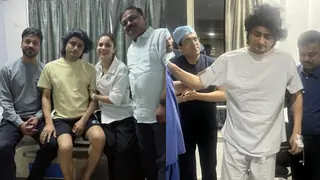Kaboom is an 'All India Dancing Championship'. Dancers from all over India take part in this talent hunt. It will be a platform for the best dancers India has to offer. Perform in front of the most well known celebrities Prabhudeva, Javed Jaffery, Naved and Ravi who judge your talent. Along with the hosts, Ravi and Naved, there will be a panel of three esteemed judges.
The two categories are: Men and Women - Free Style Solo (Age: 14-30 yrs)
The Process
Auditions - A nation-wide (4 zones - E/W/N/S) talent hunt for the best dancers in the 2 categories.
Semi-Finals - The best of 16 from each zone will compete to reach the semi-finals. Once the auditions are done, the selection panel selects the best of sixteen from each zone for every category. And the selected participants will be brought down to Mumbai to further their talent. There will be four semi-final episodes where 6 participants in each episode will compete with each other. There will be two winners who will take on the ultimate challenge to enter the Grind!
The Judges
Javed Jaffery
Prabhu Deva
Naved and Ravi
Dances in India
India is a land of rich culture and heritage. The vast culture, language, style, history and tradition have all evolved into today's arts like dance, music, drama and others. Today, dance has become an integral part of us and has taken different forms and meanings. There are many types of dances in India, from those which are deeply religious in content to those which are danced on more trivial happy occasions. India is famous for Classical Dances and Folk Dances.
Classical Indian Dances:
1) Kathakali and Mohini Attam from Kerala
2) Bharata Natyam from Tamil Nadu
3) Kuchipudi from Andhra Pradesh
4) Odissi from Orissa
5) Kathak from Uttar Pradesh
6) Manipuri from Manipur
Few Indian Folk Dances:
1) Rouff and Dumhal of Kashmir
2) Hikat of Himachal Pradesh
3) Natio and Namagen of the Kulu valley
4) Doms and Bhotiyas of Uttar Pradesh
5) Dalkhai of Orissa
6) Brita or Vrita of West Bengal
7) Bihu of Assam
Origin of Indian Dance
The Natya Shastra - The Natya Shastra was created in the beginning of Treta Yug by Brahma on the request of Indra and other devas as an object of diversion (Kridaniyaka). As the lower castes (Shudras) were not entitled to listen to the four Vedas (Sama, Yajur, Rig and Atharav), Brahma created the Natya Shastra as the fifth Veda which was open to all, irrespective of caste and creed.
Elements of Indian Dance
1) Abhinaya - Abhinaya has been analysed in the Natya Shastra and has been categorised into four types:
a) Angika
b) Vachikabhinaya
c) Aharyabhinaya
d) Satvikabhinaya
2) The Navrasas
a) Hasya (happiness)
b) Krodha (anger)
c) Bhibasta (disgust)
d) Bhayanaka (fear)
e) Shoka (sorrow)
f) Veera (courage)
g) Karuna (compassion)
h) Adbhuta (wonder)
i) Shanta (serenity)
3) Slokas specific to Classical dance
4) The Natya Krama




















